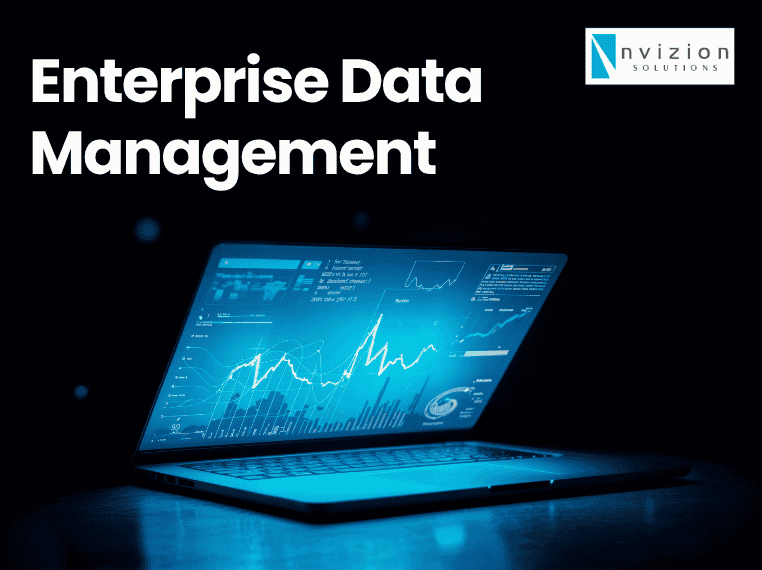What Is Enterprise Data Management (EDM)? How It Works

What Is Enterprise Data Management (EDM)? Definition & How It Works
Modern businesses rely on huge amounts of data. Sales figures, customer details, product information, financial records, it all adds up fast. But collecting data is only part of the story. Companies also need to manage it well.
That’s where enterprise data management (EDM)comes in.
EDM helps keep data accurate, organized, and useful. Without it, businesses struggle to find the right data, make decisions, or protect sensitive information.
Enterprise data management (EDM) is the set of processes, tools, and rules a business uses to handle all its data.
It covers everything from how data is collected and stored to how it’s shared, secured, and kept accurate.
The goal of EDM is to make sure data:
· Is easy to find
· Is reliable and up-to-date
· Stays secure and private
· Follows laws and industry standards
· Helps people do their jobs better
Think of EDM as a system for keeping your business’s data house in order.
Why Is Enterprise Data Management Important?
Data is one of a company’s most valuable assets. But if data is scattered, outdated, or incorrect, it becomes a problem instead of an advantage.
Without proper EDM, businesses face issues like:
· Duplicate or conflicting data
· Errors in reports
· Slow decision-making
· Compliance risks and fines
· Poor customer service
EDM helps prevent these problems. It ensures that everyone from leadership to frontline staff can trust the data they use every day.
Key Components of Enterprise Data Management
Good enterprise data management covers several key areas. Let’s break them down in plain language:
Data Governance
Data governance means setting rules about how data is used and who can access it.
It covers:
· Data ownership: Who “owns” the data and decide show it’s used?
· Policies: Rules for storing, sharing, and securing data
· Data definitions: Making sure everyone uses the same terms and meanings
Without governance, people use data differently, leading to confusion and mistakes.
Data Quality
Data quality means keeping data:
· Correct
· Complete
· Free of duplicates
· Consistent across systems
For example, customers shouldn’t have two different addresses in two systems. Data quality tools help catch errors and fix them.
Data Integration
Data often lives in different places like finance systems, CRM tools, or spreadsheets. Data integration connects those systems so information flows smoothly.
This prevents data silos, where each department has its own data but can’t see the full picture.
Data Security and Privacy
Businesses must protect data from hackers, leaks, or mistakes. Security includes:
· Password protection
· Encryption
· Access controls (who can see what)
Privacy laws like GDPR or CCPA add extra rules about how personal data is collected and used.
Data Architecture
Data architecture is how data is structured and organized. It includes:
· Databases
· Data warehouses
· Data lakes
· Cloud storage
A good architecture makes data easy to store, find, and analyze.
Master Data Management (MDM)
Master data management focuses on the most important data, like customer records, product lists, or supplier details.
MDM creates one trusted version of this data, shared across all systems.
How Does EDM Work?
Let’s look at how EDM functions step by step:
1. Data Collection
Businesses gather data from many places:
· Sales systems
· Customer service platforms
· Websites
· Mobile apps
· Machines and sensors
2. Data Storage
Data gets stored safely in systems like databases, data warehouses, or cloud services.
3. Data Organization
Data is sorted and structured so it’s easy to search and use. For example:
· Putting fields into tables
· Using consistent formats for dates or addresses
· Assigning clear names to data elements
4. Data Cleaning and Quality Checks
Businesses check data for mistakes. They remove duplicates, fill in missing details, and ensure formats match.
5. Data Integration
Systems connect so data moves smoothly between them. For instance, sales data might link to inventory systems to update stock levels.
6. Data Security and Privacy Controls
Companies put security measures in place. They also ensure data handling follows privacy laws.
7. Data Access and Analytics
Authorized users can find and analyze data to make decisions, run reports, or plan business strategies.
This whole process keeps data reliable, safe, and useful.
Building a Winning Enterprise Data Management Strategy
An enterprise data management strategy is a plan for how a business will handle its data long term.
Here’s how to build a solid strategy:
Set Clear Goals
Ask questions like:
· What business problems are we trying to solve?
· Do we want faster reporting?
· Do we want to improve customer service?
Define Roles and Responsibilities
Decide who owns which data and who has authority to make decisions about it.
Assess Your Current State
· Where does your data live now?
· Are there silos or duplicates?
· How good is your data quality?
Choose the Right Tools
Select tools for data storage, quality checks, integration, and security. Look for solutions that fit your size, budget, and needs.
Create Data Standards
Set rules for:
· Naming data fields
· Data formats (e.g., dates, currencies)
· Data validation rules
Train Your Team
Teach staff how to use new tools and follow data policies. Even the best systems fail if people don’t use them correctly.
Monitor and Improve
Check regularly for errors, gaps, or changes in business needs. Keep improving your EDM strategy over time.
An effective enterprise data management strategy helps businesses stay organized, compliant, and ready for the future.
Benefits of Enterprise Data Management
Businesses that invest in EDM gain many benefits:
· Better decisions based on trusted data
· Faster reporting and analytics
· Lower risk of errors and compliance issues
· Improved customer experiences
· Cost savings through less manual work
· More agility in adapting to new business needs
· Good EDM turns data from a burden into a business advantage.
Common Use Cases of EDM
EDM helps in many areas:
Customer Data Management
· Keep one clean record for each customer
· Personalize marketing and service
Financial Reporting
· Combine data from multiple systems for accurate reports
· Meet regulatory requirements
Product Information Management
- Keep product details consistent across websites, catalogs, and partners
Compliance and Risk Management
· Store records for audits
· Track data access for privacy laws
Supply Chain Management
· Share data between suppliers, warehouses, and stores
· Avoid stockouts or overstocking
Challenges in Enterprise Data Management
Even with good intentions, businesses often struggle with EDM. Challenges include:
Data Silos
Departments may guard their own data and resist sharing.
High Costs
EDM tools and projects can be expensive, especially for large businesses.
Complex Systems
Older systems may not work well with newer tools, making integration hard.
Data Quality Issues
Cleaning up messy data takes time and resources.
Privacy and Security Risks
Laws change often, and keeping up with privacy rules is challenging.
Despite the challenges, businesses that stick with EDM gain big advantages.
Data is one of the most valuable assets any business owns. But data only helps if it’s managed well.
Enterprise data management keeps information accurate, secure, and ready to support business goals.
A strong enterprise data management strategy helps businesses reduce risks, improve decision-making, and stay competitive.
Whether you’re a small company or a large enterprise, investing in EDM is no longer optional, it’s essential.
Nvizion Solutions helps organizations design and implement enterprise data management strategies that break down data silos, improve data quality, and ensure compliance. We blend technology, process expertise, and best practices to keep your data secure, integrated, and ready to drive business insights
Faq
What is the role of data governance in EDM?
Data governance sets the rules for how data is collected, stored, and shared. It ensures everyone uses data the same way and keeps it safe and compliant.
What are some signs your business needs EDM?
You might need EDM if you have:
· Data scattered across systems
· Duplicate or conflicting data
· Slow reports or analytics
· Trouble meeting privacy rules
What is the cost of implementing an EDM system?
Costs vary a lot. Small tools might cost thousands. Large enterprise solutions can run into millions, depending on size, complexity, and licensing fees.
What industries benefit the most from EDM?
Industries like finance, healthcare, retail, manufacturing, and telecommunications rely heavily on EDM. Any business with lots of data can benefit.
